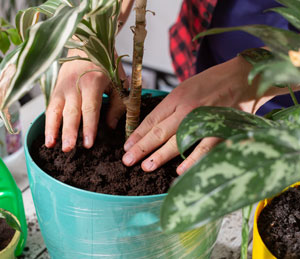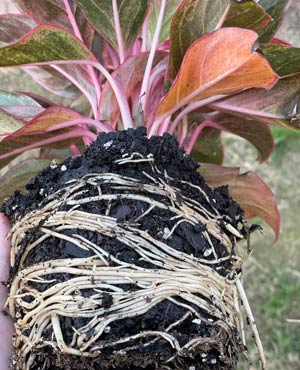Repotting & Fertilizing Houseplants
Searcy, Ark. –
 Houseplants periodically require repotting to keep them healthy and growing. But few
houseplants will need repotting more frequently than once a year, and most will only
need repotting once every three to five years.
Houseplants periodically require repotting to keep them healthy and growing. But few
houseplants will need repotting more frequently than once a year, and most will only
need repotting once every three to five years.
The use of some mineral soil in the potting helps reduce the need for frequent repotting.
How can I tell if my plant needs repotting?
Houseplants will tell you when repotting is needed.
Look for these things:
- When the plant begins drying out between waterings, repotting may be needed.
- Top-heavy plants that are prone to fall over, especially when they get dry, need repotting.
- When plants start producing small leaves and almost no new growth, repotting is needed.
- If a salty crust is seen on the soil surface, repot and replace as much of the soil
as possible.
What's the best time of year to re-pot?
Repotting almost always encourages new growth, so it is best to repot in late winter just as the natural light level is increasing and the plants are awakening from their winter doldrums. Most plants grow as large as their root system will allow. So, as a rule, the larger the pot, the larger the root mass and the larger the plant. But keep in mind that large plants require a lot more room inside the home and are more difficult to move outside during the summer.
Is it okay to let some plants get rootbound?
Frequently, it is better to be a bit stingy when it comes to repotting plants. Keeping them a bit rootbound keeps them smaller and easier to manage. Pot size is usually increased incrementally; begin with small pots and gradually increase pot size as the plant grows.
Should I cut any circling roots when repotting?

Yes. When repotting, cut any circling roots you find. If dead, sloughing roots are present, be sure to remove these.
Replace as much of the old soil as possible without overly disturbing the roots. When you replant, make sure the top of the root ball is at the same position as in the original pot. Don’t plant it deeper.
What type of container is best for my plants?
About anything – plastic, clay, ceramic, metal, or wood – can be used for plant containers. However, one requirement is critical. The container must have a drainage hole at the bottom of the pot. If the container does not have a drainage hole in the bottom, it is almost impossible to water the plant without either over or under watering.
The decorative containers you find in all of the shops that lack drainage holes are intended as sleeves for a regular pot, not as a planting container. If you tend to over water, you may have better luck with clay pots because plant roots stay drier. If you consistently find yourself under watering, plastic or ceramic pots may be the best choice because they lose less water than clay pots.
Success or failure with houseplants often comes down to your ability to water the plants correctly.
The plants are completely at your mercy, and if they survive or die depends on the care you give them. Because water needs are immediate and ongoing, proper watering will be your first test. People seem about equally divided between those prone to over water or under water.
The kind of plant, the time of year, the size of the plant, weather conditions, light levels, the amount of air movement, the relative humidity and a host of other large and small factors all influence water uptake. Your goal is to interpret these conditions and get it just right – neither over or under doing the job. The appearance of the plant and your finger are the best guides to water needs.
Most plants do best when the soil dries slightly between waterings but not to the point that the plant wilts. An occasional wilting will not hurt most plants, but some plants, such as schefflera, croton and aphelandrea, begin dropping lower leaves if this happens too often. Dracaenas and wandering Jews often have burned leaf tips if allowed to get too dry.
What signs should I look for to determine under or over watering?
Plants that are continually maintained on the too dry side usually have little new growth and often have dull, unhealthy looking foliage. If plants are kept too wet, root growth will be reduced, and many of the same symptoms mentioned above occur. For example, wilting and leaf drop are often the first signs of extreme over watering.
What's the best way to tell if my plant needs watering?
Stick your finger in the soil before watering, and only water when it is dry to the touch. Both wintertime heating and summertime air conditioning dehumidify the atmosphere, so plants may need more water during the heating and cooling seasons than the rest of the year. Your finger is the best method of determining water needs, not the day of the week. Water gadgets that measure soil moisture are available, but they are of little practical value and are no better than your finger.
When I do water, should I water slowly? Does it matter?
When you water, apply enough so that about 10 percent of the water given to the pot runs out the drainage hole in the bottom of the container. If the soil has become really dry since the last watering, apply half the normal amount of water, and let that soak in. Then, come back in a few minutes and water a second or third time to make sure the soil ball is completely wetted.
Be careful about decorative containers without drainage holes.
One of the common causes of plant death occurs when the flowerpot is inserted inside a decorative container. These are handy for keeping down spills and protecting the floor and carpet, but they can be a death trap for the plant. Any water that runs through the pot begins to accumulate in the bottom of the decorative container. After a few waterings, the plant will be in water and the soil ball will be completely saturated. Anaerobic rot sets in, and before long the roots will become a stinking mass of organic debris.
To avoid this scenario, pour any excess water out of the pot soon after watering. If the pot is too large and this is not possible, put a layer of gravel or stones at the bottom of the pot to elevate the pot off the bottom of the container. Then, stick a bamboo pole beside the pot to the bottom of the decorative container to use as a dipstick to test the depth of the water level. If too much water is found, delay watering.
Can water quality affect my houseplant?
Water quality sometimes becomes an issue with houseplants. Municipal water supplies are always acceptable for watering houseplants. Chlorine added to the water during purification has no adverse effects on plants.
Some well water sources around Arkansas may have high salt content, have high carbonate levels or be very hard. Because the salt residue remains behind (and builds up) as the plant loses water through evaporation, high salt content water is a problem for houseplants. Plants grown using water with high salt levels show a white, crusty scale at the top of the soil and eventually stop growing as the level becomes too high.
Hard water and water with high carbonate levels also lead to salt deposits on the soil surface. Watering with rainwater or some surface water source should solve the problem.
If a salt-based water softener is used in the home, water for houseplants should be collected before it enters the water softener unit.
When and how often should I fertilize my houseplants?
Houseplants are not heavy feeders and do not require a lot of fertilizer for maintenance. However, they are grown in artificial potting mixes that have almost no nutrients. So if you expect to see them continue to grow, they must receive occasional fertilization. Keep in mind that poor growth can be caused by a number of factors – low light, wrong temperature, wrong watering regime, etc. – and adding extra fertilizer in an attempt to force the plant to grow will be completely ineffective if the cause of poor growth is not a lack of nutrition.
Most new plants have sufficient nutrients from the greenhouse where they were grown to sustain them for two to three months. When the nutrients are depleted, the plant will only grow if fertilized. Plants respond best to fertilization in late winter and spring as growing conditions are improving.
During the fall and winter when light is low and conditions are less ideal, reduce or withhold fertilization completely to force the plant into a kind of rest period
What kind of fertilizer should I use?
For convenience sake, most prefer to use one of the many kinds of fertilizer products designed specifically for houseplants. These come in several different analyses, with the most common types having a 1:1:1 ratio of nitrogen to phosphate to potassium. A commonly available analysis is one containing 20-20-20. Some products are still seen with the 1:2:1 ratio, with analyses such as 15:30:15 being fairly common. Most current data suggests that the extra phosphorus is not needed and may actually encourage stem stretching and weak growth.
Some of these products are supplemented with trace minerals, which can be important if a plant is grown long term in a completely artificial potting mix. If some soil has been added to the potting mix, the presence of trace minerals is not important.
Highly soluble fertilizer salts that are dissolved in water are the easiest fertilizers to use. These are convenient, easy to use and give good results, provided they are applied according to recommendations.
Most manufacturers recommend fertilizing once every two weeks, but monthly feeding is usually adequate. In the wintertime, fertilization should be curtailed.
Several types of slow-release fertilizer products are available for houseplants as well as various kinds of slowly available organic fertilizers. These products provide the convenience of continual feeding for three or four months without the hassle of measuring and mixing. However, they tend to produce less dramatic results than liquid fertilization. A good strategy might be to use the water-soluble fertilizer during the brighter days of summer and the slow-release products during the darker days of winter.
By Sherri Sanders
White County Extension Agent - Agriculture
The Cooperative Extension Service
U of A System Division of Agriculture
White County Cooperative Extension Service
2400 Old Searcy Landing Road Searcy AR 72143
(501) 268-5394
ssanders@uada.edu